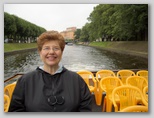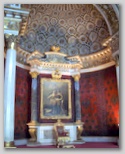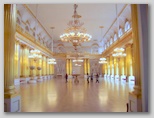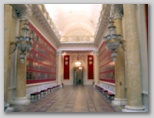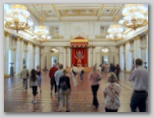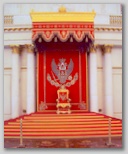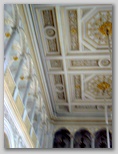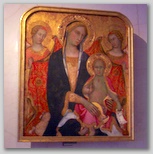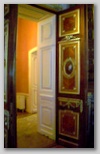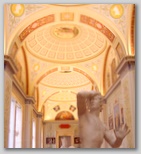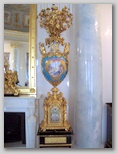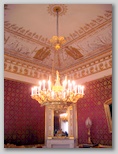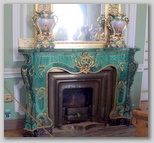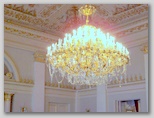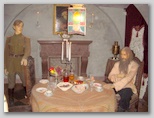Back to
Contents - Previous - Next
July 6 –
Click a picture to see a
larger view.
Today, we spent the
day in the luxurious haunts of Russian aristocracy. We started by experiencing
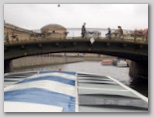
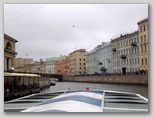 The
The
First we took a barge trip along the
Our ride along the canal took us close to the Hermitage, but we boarded our bus back to the river entrance. Our guide explained that we would normally enter by the wide plaza side; however, a stage and seating was being set up for a performance later that night by Elton John as part of the White Nights festival. It seems that the Russians here like Elton John and that the affection is returned. He performs here each year.
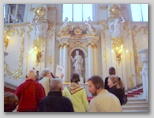 We entered the Hermitage
early before the opening to the general public at 10:30 AM.
We entered the Hermitage
early before the opening to the general public at 10:30 AM. 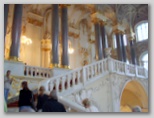 There was just our tour
group of about twenty and about two-hundred tourists from other ships. This is
when the experience of our guide Margareta proved useful. She found a friend who
was guiding another group near the head of the line and, after a short
conference between them, Margareta instructed us to walk beside the group.
“Walk dignified,” she instructed, which I took to mean “pretend there is
nothing out of the ordinary.” The other expression that Margareta used
frequently was “step lively.” No explanation needed.
There was just our tour
group of about twenty and about two-hundred tourists from other ships. This is
when the experience of our guide Margareta proved useful. She found a friend who
was guiding another group near the head of the line and, after a short
conference between them, Margareta instructed us to walk beside the group.
“Walk dignified,” she instructed, which I took to mean “pretend there is
nothing out of the ordinary.” The other expression that Margareta used
frequently was “step lively.” No explanation needed.
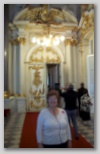 The Hermitage was the winter
palace of the czars and was the place in which they housed their extensive art
collection. When it was opened to the public after the 1917 revolution, it
immediately became one of the premiere art collections of the world. The czars
had created a ready-made world-class art museum. The breadth of the collection
is astounding with works from the Flemish masters such as Rembrandt, those of
El Greco and others from
The Hermitage was the winter
palace of the czars and was the place in which they housed their extensive art
collection. When it was opened to the public after the 1917 revolution, it
immediately became one of the premiere art collections of the world. The czars
had created a ready-made world-class art museum. The breadth of the collection
is astounding with works from the Flemish masters such as Rembrandt, those of
El Greco and others from 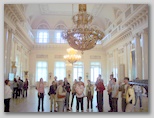 and abstracts of Picasso.
and abstracts of Picasso.
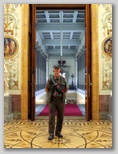 I stopped in front of the
sculpture of the Three Graces and it was then that I realized that I was seeing
so much that, until now, were photos in art books with the footnote “from the
Hermitage.” There was another readjustment in my thinking. Towards the end of
the collection we saw the works of Matisse and Picasso. I think of as that art as
being collected in the twentieth century. I had to stop and realize that
Nicolas and Alexandra, in spite of all those photos in horse and carriage, were
indeed rulers of the twentieth century.
I stopped in front of the
sculpture of the Three Graces and it was then that I realized that I was seeing
so much that, until now, were photos in art books with the footnote “from the
Hermitage.” There was another readjustment in my thinking. Towards the end of
the collection we saw the works of Matisse and Picasso. I think of as that art as
being collected in the twentieth century. I had to stop and realize that
Nicolas and Alexandra, in spite of all those photos in horse and carriage, were
indeed rulers of the twentieth century.
The art is one part of the Hermitage, but not the only thing. Before seeing your first work of art, you enter grand gilded staircases, a throne room, grand ballrooms and other parts of a functioning palace of rulers. Before the trip, we saw the movie Russian Ark. That movie progressed through the Hermitage in one single take and, as it did, hundreds of actors in period dress depicted scenes from the royal court. I could see those scenes in my mind’s eye as I walked the very spots where those events took place.
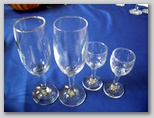 After the Hermitage, we
were bused to a large dining hall for a fine Russian lunch of salmon while
being entertained by a quartet playing Russian folk music.
After the Hermitage, we
were bused to a large dining hall for a fine Russian lunch of salmon while
being entertained by a quartet playing Russian folk music.
In the afternoon,
we toured The Yusupov Palace. This long yellow building was once was a
residence of the wealthy and respected Yusupov family. The Yusupov’s descended
from a family in the Asian east of
